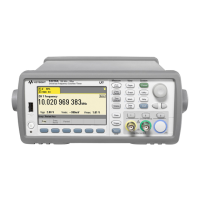252 53220A/53230A User’s Guide
7 Formats and Data Flow
The command used to transfer data from reading memory to a file in internal
flash memory or on a USB device (Figures 7-1 and 7-2) is:
MMEMory:STORe:DATA RDG_STORE, “<file>”
<file> is created during execution of the command and the file parameter
format is “[drive:path]<file_name>”. drive is either INT (internal flash
memory) or USB (external memory device). path is an absolute path and
folder name. If a folder is specified, it must have been previously created.
The combination of folder and file name cannot exceed 240 characters, and
cannot contain the characters \ / : * ? “ < > |.
The format of the transferred readings is specified by the file_name exten-
sion. If .csv is specified, the data is stored as comma-separated values (CSV)
in one measurement per line ASCII format. If .dat is specified, the data is
stored as REAL values with little-endian byte order.
The following sequence of commands creates a folder on a USB memory
device, takes a set of frequency measurements, and then creates a file and cop-
ies the measurements to the folder from (volatile) reading memory.
Creating a Data File Example
MMEM:MDIR “USB:\dut_1” // create folder in USB memory
MMEM:CDIR “USB:\dut_1” // specify a current folder
CONF:FREQ 100E3,(@1) // configure measurement
SAMP:COUN 50 // set 50 measurements
INIT // initiate measurements
*WAI // wait for readings to complete
MMEM:STOR:DATA RDG_STORE, “data1.csv” // create file, copy

